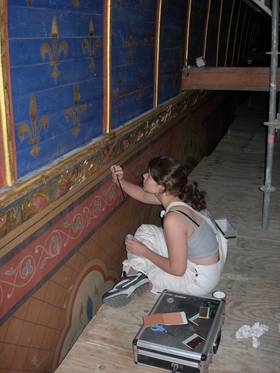- Home >
- Royal chateau of Blois >
- Collection >
- Restoration
Restoration

 In a sustained attempt to transmit the cultural heritage to generations yet to come, preventive measures can slow the aging and deterioration of our patrimony. At times, however, heritage restoration is unavoidable. And since degradation is an irreversible process, restoration is often a complicated operation undertaken by specialists with scientific and artistic skills who take care not to denature or water down the objects they endeavor to restore.
In a sustained attempt to transmit the cultural heritage to generations yet to come, preventive measures can slow the aging and deterioration of our patrimony. At times, however, heritage restoration is unavoidable. And since degradation is an irreversible process, restoration is often a complicated operation undertaken by specialists with scientific and artistic skills who take care not to denature or water down the objects they endeavor to restore.
The historical monument
In 1840, on the initiative of Prosper Merimee, the Royal Chateau of Blois was inscribed on the list of historical monuments and restored with funds from the French State. Nowadays owned by the town of Blois, the chateau is subject to continual scrutiny that regularly leads to new work projects. Conducted under the supervision of a specialized architect, the projects are submitted for approval to the French Culture Ministry, and may receive funding.
The objects in the collections
Degree-holding curator-restorers from the national patrimonial institute restore the possessions of the museums of France. Restoration projects are submitted for approval to a regional scientific committee that defines the intervention procedure and decides on the materials to be used. The work projects may be eligible for financing by the French Culture Ministry, but given the scale of the task, the support of patrons has become increasingly necessary.
In figures
Conducted by Félix Duban, the initial restoration campaign lasted 25 years.
The cost of the decor restorations carried out from 2004 to 2007 in the Francis I wing came to 2,310,000 €, to which 829,000 € were added to bring electrical facilities and equipment up to standard.
Currently open from 10am to 5pm (last entrance at 4:30pm)









